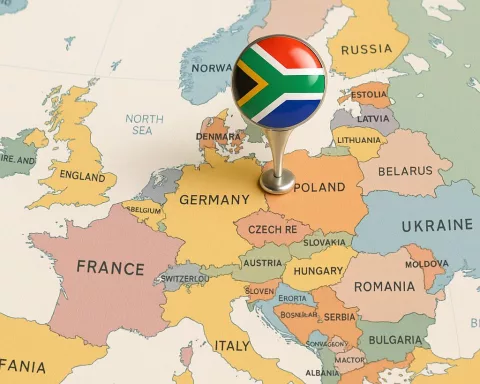The swift reopening of vital roads after the recent storms in South Africa’s Western Cape is a remarkable achievement, as many communities were cut off and in need of assistance. Collaboration between government, civil society, farmers, and private sector teams led to a thorough cleanup operation that resulted in the reopening of several key routes within 48 hours. The reopening of these roads facilitated the delivery of aid to previously unreachable communities and helped to restore dignity.
Extreme weather conditions often lead to communities being cut off, disconnected, and in dire need of support. Nevertheless, rapid, efficient, and effective actions by authorities can alleviate hardships, reestablish normalcy, and provide much-needed aid. The recent swift reopening of roads in South Africa’s Western Cape is a prime example of such timely and commendable initiatives.
Challenging Weather and the Struggle of Disconnected Communities
The Western Cape Department of Infrastructure encountered a significant obstacle when the area experienced severe weather, causing several vital roads to close. As the number of closed roads reached an all-time high, accessing some communities became virtually impossible, resulting in delays in delivering crucial relief goods and services.
Thorough Cleanup Efforts and Collaboration
In an admirable attempt to reconnect affected communities and restore their dignity, multiple joint operation teams, including various layers of government, civil society, the private sector, and farmers, collaborated in an extensive cleanup operation. The combined efforts of these diverse groups, along with the commitment of local citizens, led to the swift reopening of numerous key routes within the first 48 hours after the storm.
Essential Roads Reopened, Aid Provided
The number of closed roads significantly decreased to 72, signifying a remarkable achievement in the restoration process. Some of the notable routes that reopened include the N1 at De Doorns, the R44 at the Palmiet River Bridge on the Betty’s Bay approach side, and the low water bridge at Buffeljaags River near Swellendam. The reopening of the N12, which connects Beaufort West and De Rust, was another substantial accomplishment. The timely restoration of these vital routes significantly eased the delivery of aid to the previously unreachable communities.
The reopened roads also encompassed Sir Lowry’s Pass, R62 from Barrydale to Montagu, R60 from Robertson to Worcester, MR205 from Klapmuts to Simondium, Tradouw Pass, MR262 from Bredasdorp to Elim, MR265 from Bredasdorp to Stormvlei, TR28/2 from Hermanus to Stanford, TR30/2 from Villiersdorp to Worcester, and the low water bridge across the Buffeljags River near Swellendam.
Recognizing Accomplishments and Focused Initiatives
Acting Provincial Minister of Infrastructure Anroux Marais lauded the progress achieved by the cleanup teams. In recognizing their efforts, she said, “I am deeply encouraged by the efforts of the joint operation teams…who offered a helping hand during our province’s time of need.” She stressed the significance of reopening these routes, as it not only reconnected struggling communities with their loved ones but also facilitated the delivery of essential relief aid.
Minister Marais also highlighted the importance of resuming commerce through the transportation of goods and services to the market, stating that it was crucial in rebuilding the province and its economy after the weekend’s disturbances.
Evaluating Damages and Moving Ahead
While authorities continue to assess the damage to infrastructure, initial reports indicate that 3986 informal structures were affected throughout the City of Cape Town. The Western Cape Government and its partners remain dedicated to making concerted efforts to ensure quick restoration and maintain the dignity of their citizens.
The Impact of Partnership and Commitment
The rapid reopening of roads in the Western Cape, along with the focused endeavors of various joint operation teams and the dedication of local citizens, showcases the power of collaboration, hard work, and resilience in overcoming adversity. The swift restoration of crucial routes, delivery of relief aid, and resumption of commerce will undoubtedly contribute to the region’s recovery, as it emerges stronger and more united than before.
1. What led to the closure of several vital roads in South Africa’s Western Cape?
Severe weather conditions caused the closure of several vital roads in South Africa’s Western Cape.
2. How did the closure of these roads affect communities?
The closure of these roads led to communities being cut off, disconnected, and in dire need of support, resulting in delays in delivering crucial relief goods and services.
3. What collaborative efforts were made to reopen the closed roads?
Multiple joint operation teams, including various layers of government, civil society, the private sector, and farmers, collaborated in an extensive cleanup operation to reopen the closed roads.
4. How many roads were reopened, and what are some notable ones?
The number of closed roads significantly decreased to 72, and some notable reopened roads include the N1 at De Doorns, R44 at the Palmiet River Bridge, and the low water bridge at Buffeljaags River near Swellendam.
5. How did the reopening of these roads help communities?
The reopening of these roads facilitated the delivery of aid to previously unreachable communities and helped to restore dignity.
6. What did the Acting Provincial Minister of Infrastructure say about the accomplishments of the cleanup teams?
Acting Provincial Minister of Infrastructure Anroux Marais lauded the progress achieved by the cleanup teams and stressed the significance of reopening these routes.
7. What impact did the closure of roads have on informal structures in the City of Cape Town?
Initial reports indicate that 3986 informal structures were affected throughout the City of Cape Town.
8. What does the swift restoration of crucial routes, delivery of relief aid, and resumption of commerce contribute to the region’s recovery?
The swift restoration of crucial routes, delivery of relief aid, and resumption of commerce will undoubtedly contribute to the region’s recovery, as it emerges stronger and more united than before.








